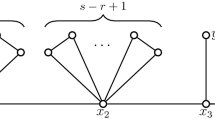Abstract
The game domination subdivision number of a graph \(G\) is defined by the following game. Two players \(\mathcal D \) and \(\mathcal A \), \(\mathcal D \) playing first, alternately mark or subdivide an edge of \(G\) which is not yet marked nor subdivided. The game ends when all the edges of \(G\) are marked or subdivided and results in a new graph \(G^{\prime }\). The purpose of \(\mathcal D \) is to minimize the domination number \(\gamma (G^{\prime })\) of \(G^{\prime }\) while \(\mathcal A \) tries to maximize it. If both \(\mathcal A \) and \(\mathcal D \) play according to their optimal strategies, \(\gamma (G^{\prime })\) is well defined. We call this number the game domination subdivision number of \(G\) and denote it by \(\gamma _{gs}(G)\). In this paper we initiate the study of the game domination subdivision number of a graph and present sharp bounds on the game domination subdivision number of a tree.
Similar content being viewed by others
References
Alon N, Balogh J, Bollobás B, Szabó T (2002) Game domination number. Discret Math 256:23–33
Blidia M, Chellali M, Favaron O (2005) Independence and 2-domination in trees. Australas J Comb 33:317–327
Author information
Authors and Affiliations
Corresponding author
Rights and permissions
About this article
Cite this article
Favaron, O., Karami, H. & Sheikholeslami, S.M. Game domination subdivision number of a graph. J Comb Optim 30, 109–119 (2015). https://doi.org/10.1007/s10878-013-9636-6
Published:
Issue Date:
DOI: https://doi.org/10.1007/s10878-013-9636-6



